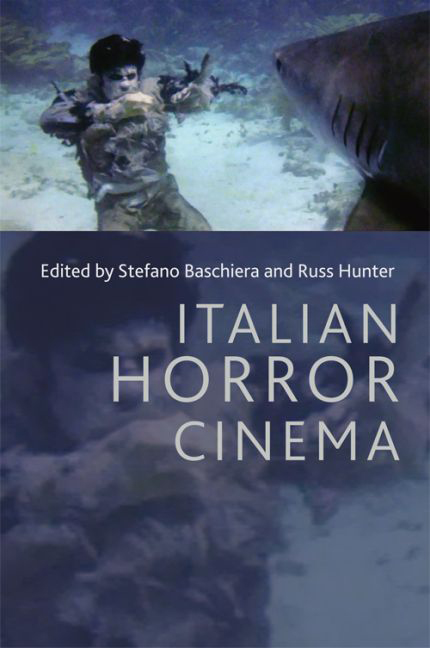Book contents
- Frontmatter
- Contents
- List of figures
- List of contributors
- Acknowledgements
- Introduction
- 1 Preferisco l'inferno: early Italian horror cinema
- 2 Domestic films made for export: modes of production of the 1960s Italian horror film
- 3 The 1980s Italian horror cinema of imitation: the good, the ugly and the sequel
- 4 Knowing the unknown beyond: ‘Italianate’ and ‘Italian’ horror cinema in the twenty-first century
- 5 Bavaesque: the making of Mario Bava as Italian horror auteur
- 6 The Argento Syndrome: aesthetics of horror
- 7 Scrap metal, stains, clogged drains: Argento's refuse and its refusals
- 8 The giallo /slasher landscape: Ecologia del delitto, Friday the 13th and subtractive spectatorship
- 9 Kings of terror, geniuses of crime: giallo cinema and fumetti neri
- 10 Political memory in the Italian hinterland: locating the ‘rural giallo’
- 11 The horror of progressive rock: Goblin and horror soundtracks
- 12 ‘The only monsters here are the filmmakers’: animal cruelty and death in Italian cannibal films
- 13 Italian horror cinema and Italian film journals of the 1970s
- Index
8 - The giallo /slasher landscape: Ecologia del delitto, Friday the 13th and subtractive spectatorship
Published online by Cambridge University Press: 12 September 2017
- Frontmatter
- Contents
- List of figures
- List of contributors
- Acknowledgements
- Introduction
- 1 Preferisco l'inferno: early Italian horror cinema
- 2 Domestic films made for export: modes of production of the 1960s Italian horror film
- 3 The 1980s Italian horror cinema of imitation: the good, the ugly and the sequel
- 4 Knowing the unknown beyond: ‘Italianate’ and ‘Italian’ horror cinema in the twenty-first century
- 5 Bavaesque: the making of Mario Bava as Italian horror auteur
- 6 The Argento Syndrome: aesthetics of horror
- 7 Scrap metal, stains, clogged drains: Argento's refuse and its refusals
- 8 The giallo /slasher landscape: Ecologia del delitto, Friday the 13th and subtractive spectatorship
- 9 Kings of terror, geniuses of crime: giallo cinema and fumetti neri
- 10 Political memory in the Italian hinterland: locating the ‘rural giallo’
- 11 The horror of progressive rock: Goblin and horror soundtracks
- 12 ‘The only monsters here are the filmmakers’: animal cruelty and death in Italian cannibal films
- 13 Italian horror cinema and Italian film journals of the 1970s
- Index
Summary
How Italian is the American slasher film? How American is the Italian giallo film?
I begin with these questions not because they have never been asked, but because the answers that are usually offered have not encouraged us to take the relationship between these two important horror film sub-genres as seriously as we should. By examining a seminal Italian giallo, Mario Bava's Ecologia del delitto /The Ecology of Murder (1971, also known as Antefatto, Reazione a catena, A Bay of Blood, Carnage, Last House – Part II and Twitch of the Death Nerve) alongside a phenomenally popular American slasher film that bears an uncanny resemblance to it, Sean S. Cunningham's Friday the 13th (1980), I will argue that we have more to learn about these well-known sub-genres than we might have imagined. More specifically, the centrality of natural landscape to both films suggests that the giallo and the slasher film can cross-pollinate to enable what I will call a ‘subtractive spectatorship’ that challenges some of our conventional assumptions about what watching graphic horror is all about.
Most scholars and viewers have a fairly well-defined sense of what they mean when they talk about the Italian giallo, the American slasher film and the relationship between them. Indeed, one of the appealing aspects of these two sub-genres seems to be the relative clarity about what constitutes their core semantic/syntactic elements and most influential examples, even if deeper questions concerning their similarity to or difference from related types of films remain unresolved. The Italian giallo takes its name (‘yellow’) from the colour of those books issued by the Milanese publisher Mondadori that featured mystery and detection elements associated with authors such as Agatha Christie and S. S. Van Dine. Although the books began appearing in 1929, it was not until the 1960s that the giallo gained a pronounced cinematic presence with the release of Bava's La ragazza che sapeva troppo /The Girl Who Knew Too Much/The Evil Eye (1963) and Sei donne per l'assassino /Blood and Black Lace/Six Women for the Murderer (1964). Dario Argento's L'uccello dalle piume di cristallo /The Bird with the Crystal Plumage (1970) placed giallo on the international map while inspiring an intensive burst of Italian production of gialli that peaked during the early and mid-1970s but continues even today among directors like Argento, Lamberto Bava (Mario's son) and the French filmmakers Hélène Cattet and Bruno Forzani.
- Type
- Chapter
- Information
- Italian Horror Cinema , pp. 127 - 144Publisher: Edinburgh University PressPrint publication year: 2016



